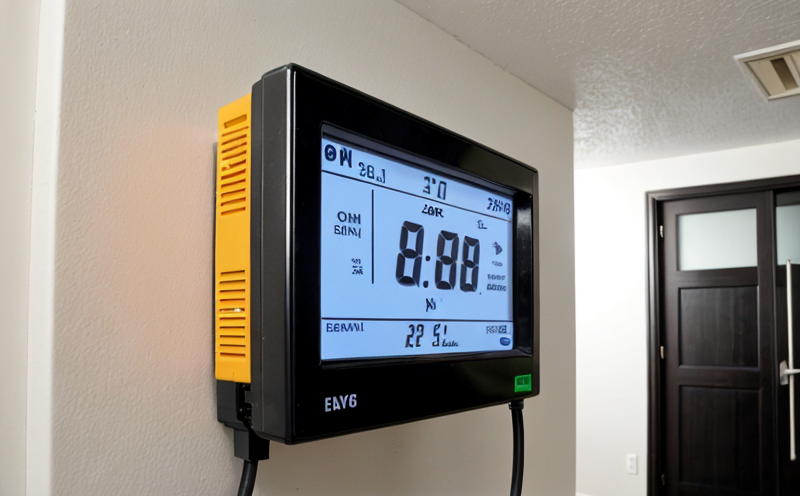ASTM C518 Thermal Conductivity Testing of Materials
The ASTM C518 standard method is a widely recognized procedure for determining the thermal conductivity of materials. This testing service plays an essential role in ensuring that building and construction materials meet specified insulation performance criteria, especially in sectors like energy efficiency, HVAC design, and renewable energy installations.
Thermal conductivity is a measure of how effectively heat flows through a material. In buildings and structures, this property is critical for maintaining optimal thermal comfort and minimizing energy consumption. ASTM C518 uses guarded hot plate apparatus to measure the thermal resistance (R-value) and subsequently calculate the thermal conductivity (λ). This method provides accurate and reliable data which helps in selecting appropriate materials that enhance overall building efficiency.
The test procedure involves placing a specimen between two plates, one of which is maintained at a constant high temperature while the other is kept at a lower temperature. Heat flows through the specimen, and by measuring the rate at which this heat transfers across the sample, researchers can determine its thermal conductivity. Compliance with ASTM C518 ensures that materials perform as expected under real-world conditions.
The accuracy of ASTM C518 testing is crucial for several reasons:
- It supports compliance with international standards and regulations related to energy efficiency.
- It helps manufacturers and suppliers verify the performance characteristics of their products before bringing them to market.
- It provides data that architects, engineers, and builders can use when specifying materials for new construction or retrofit projects.
In conclusion, ASTM C518 thermal conductivity testing is indispensable in ensuring that materials used in energy-efficient buildings meet the highest standards. By accurately measuring a material's ability to resist heat flow, this test contributes significantly to reducing overall building energy consumption and promoting sustainable practices.
Why It Matters
The importance of ASTM C518 thermal conductivity testing cannot be overstated in the realm of renewable energy and energy efficiency. As global efforts intensify towards reducing carbon footprints, it becomes increasingly vital to employ materials that not only perform well but also contribute positively to environmental sustainability.
Thermal conductivity plays a pivotal role in determining how efficiently heat is transferred within and around buildings. For instance, in solar thermal systems, poor insulation can lead to significant energy losses during the collection of solar heat. Similarly, in wind turbines or photovoltaic panels, efficient heat dissipation ensures that components operate at optimal temperatures, extending their lifespan and enhancing overall performance.
Moreover, ASTM C518 testing is not just about compliance; it's also about innovation. By accurately measuring thermal conductivity, researchers can develop new materials with enhanced insulating properties. This leads to the creation of advanced building envelopes that offer superior energy efficiency while maintaining comfort levels inside buildings.
- Reduction in Energy Costs: Improved insulation reduces heating and cooling demands, leading to lower utility bills for both residential and commercial properties.
- Sustainability: Materials with higher thermal resistance help reduce the need for additional resources by optimizing existing systems.
- Regulatory Compliance: Ensuring adherence to industry standards such as ASTM C518 helps businesses avoid potential penalties associated with non-compliance.
In summary, ASTM C518 testing is essential for anyone involved in the design, manufacturing, or certification of energy-efficient materials. It provides critical insights into material performance that can drive significant improvements across various sectors.
International Acceptance and Recognition
ASTM C518 thermal conductivity testing enjoys widespread acceptance globally due to its robust methodology and consistent results. This standard is particularly popular in countries like the United States, Canada, Australia, and parts of Europe where there are stringent regulations governing building insulation standards.
- Australia: The National Construction Code (NCC) recognizes ASTM C518 as a valid method for determining thermal conductivity. Compliance with this standard ensures that imported materials meet local safety and performance requirements.
- Canada: Under the Canadian Standards Association (CSA), ASTM C518 is referenced in several guidelines related to building envelope design, highlighting its importance within the North American market.
- European Union: Although not explicitly mandated by EU directives, many member states incorporate ASTM C518 into their national standards. This practice ensures harmonization across borders and facilitates trade between nations.
Beyond these regions, ASTM C518 is increasingly being adopted in developing countries seeking to adopt best practices from developed markets. Its international recognition underscores its value as a reliable tool for assessing material performance.
Additionally, many certification bodies worldwide accept results derived from ASTM C518 testing. This acceptance extends the utility of this standard beyond mere compliance into broader applications such as quality assurance and product endorsement programs.
Use Cases and Application Examples
The application of ASTM C518 thermal conductivity testing spans multiple industries, particularly those focused on energy efficiency. Here are some key areas where this service finds application:
- Solar Thermal Collectors: Ensuring that the insulation used in solar collectors has optimal thermal resistance helps maximize heat collection and storage.
- Photovoltaic Panels: Efficient heat dissipation within these panels prevents overheating, which can degrade performance over time. Testing materials using ASTM C518 ensures they meet necessary durability standards.
- Building Insulation: Specifying the right insulation material for walls, roofs, and floors is crucial for maintaining temperature control inside structures. ASTM C518 helps select appropriate materials that offer long-term benefits regarding energy savings.
- Retrofitting Existing Structures: When renovating older buildings to improve energy efficiency, accurate thermal conductivity measurements help choose the best insulation solutions compatible with existing infrastructure.
In each case, ASTM C518 provides a reliable method for evaluating materials based on their thermal properties. This information is invaluable not only during initial design stages but also throughout the lifecycle of products and systems.





